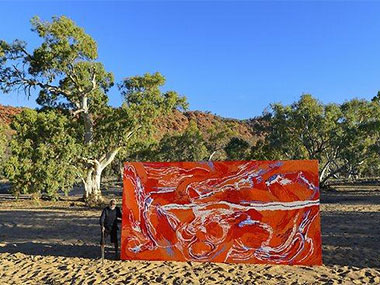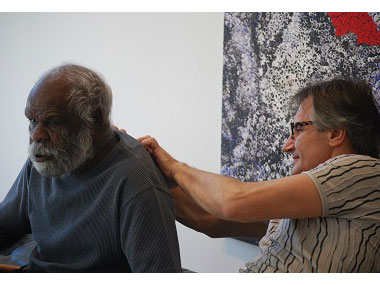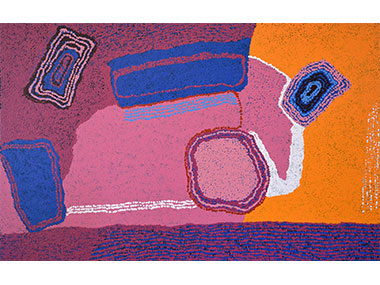Tommy Watson in Sydney

'The Australian's photo of Tommy Watson in 2013 in the Todd River with his mighty 5 metre artwork 'Ngayuku Ngura/My Country' (2013) . Photo by Steve Strike
Posted by Jeremy Eccles | 17.10.18
Gallery: Kate Owen Gallery
Dates:
06.10.18
: 11.11.18
Sydney is at last getting a serious show of the art of the late Tommy Yannima Watson – the Pitjantjatjara artist who died in 2017 aged about 82. Is it at the Art Gallery of NSW or the MCA? Sadly, no! It's at the commercial Kate Owen Gallery in Rozelle – a continuation of the black-balling of his career by major institutions and art centres since 2005 when he made a decision to leave the art centre system and opt for private dealers. He's been barely sighted in Sydney since 2013.
The old man produced scores of glorious paintings reflecting an extraordinary ability to abstract his deep understanding of Pitjantjatjara law and legend, but was cruelly abused by many in the industry for the choices he made in his relationships with white art dealers. The consequence of that abuse is that many of the artist's greatest works painted after 2005 – which, in 2007, made him the highest-paid living Aboriginal artist - are not seen in our institutions or even accepted by some auction houses for resale.
Watson's early life was typical of desert men – a nomadic life in the Gibson Desert and minimal contact with white society until the missionaries at Ernabella, later Warburton, then the pastoralists at Mt Ebenezer Station brought him in to labour for rations. It's said he helped to build the fence posts on Uluru to assist climbers. He also experienced the confusions of Papunya – officially a settlement of assimilation, but in fact housing a rebellion against that policy through art; though Watson, as a Pitjantjatjara man, was then unwilling to unveil the inner meanings of his culture. It was only in 'retirement' from 2003 in Irrunytju – or Wingellina, a tiny township just over the WA border – that he accepted the freedom to paint. And when the community offered works at auction in Sydney in order to raise funds for an art centre, his was the stand-out painting, in both quality and price.
Sadly, this primacy put him under hum-bugging pressure, and Watson with a 'niece', Jorna Newbury, left for Alice Springs, where it was all-too-easy for the artist who spoke virtually no English to be persuaded to paint for a local gallery for minimal return. A document sighted in court later revealed that the gallery thought 10% of the gallery's sale price (less costs) was a fair return for this already recognised master.
This lead to a court case in which I was involved. Tommy Watson was now working with a Melbourne dealer called John Ioannou – who took his role seriously enough to learn Pitjantjatjara and became an initiated man. In court, Watson's patent failure to understand that he might have been exploited lead to a case brought against the Alice Springs gallery and the return of paintings worth an estimated $265,000 to the artist. But Tommy's allegiance to Ioannou and his Agathon Galleries in Sydney and Melbourne lead to a total rift with the art centre community, especially when Ioannou was also invited to come in to run the Irrunytju Art Centre.
This included a threatened boycott of the important Telstra NATSIA Awards by other desert art centres if any Ioannou-associated artist was accepted. The art museums of the south joined this boycott. And, though Watson was officially selected as one of eight Indigenous artists to decorate an administrative building at the Musee du quai Branly in Paris, he was not invited to attend the 2006 opening by curators Hetti Perkins and Brenda Croft.
But Tommy Watson kept on painting. A book was dedicated to some 200 of his artworks, an Art Hotel in Adelaide is teeming with his canvases, and as his opus built and built, one might have got the impression that everything was red – with just the occasional surprising patch of oppositional colour...a ring of white, splashes of blue, a sand-blasted curve of yellow or green. As SMH critic John McDonald commented in the book, Watson had the surprising ability to instinctively mix “warm and cool shades of red”. Interpretation came from John Ioannou. “Red is essentially the colour of the initiated man in the Desert. From the red head-band Tommy wears through all his paintings, red is a recognition of the blood spilt and ceremonies he's undertaken, and the authority that comes from them”.
At the Kate Owen Gallery, the 24 works reveal an almost infinite variety of dotted patterns on red backgrounds – rhythmic and textured, sung as they were painted – spread across canvases that also succeed in imprinting the old man's knowledge of a deep diversity of Pitjantjatjara stories that go back to the flooding of his tribe's southern spinifex country when the ice last melted 10,000 years ago. Each painting may have a title – but its meaning was never explained.
Two of the artworks in Rozelle date back to Watson's Agathon period, which came to a controversial end in 2013 when Jorna Newbury insisted on looking after the old man in Alice Springs rather than in cold old Melbourne. At this point, he fell in with the legendary Chris Simon's Yanda Art – another dealer outside the community art centre network. A late flowering of significant works continued to emerge at a remarkable speed from Watson – happy to back in the desert - including an amazing 5-metre wide work which featured in The Australian newspaper, that's on sale at Kate Owen with a price almost certainly exceeding a million dollars.
Yes – it's got less detail than a classic Watson. But it's got a dynamic movement all of its own.
Another stand-out for me is 'Anumarapiti' (2015) named after Tommy's birthplace but showing that reinterpretation never ceased for the artist. For it gives off an almost late-Matisse sensibility thanks to an unusual patch of yellow in one corner and a series of rectangles and circles scattered around the canvas, not unlike the French artist's cut-outs in 'The Snail'. A mere $145,000!
Either of these works ought to go to a major institution as prized examples of the aesthetic creativity of this deeply spiritual old man.
URL: https://www.kateowengallery.com
Share this:
»  del.icio.us
»
del.icio.us
»  Digg it
»
Digg it
»  reddit
»
reddit
»  Google
»
Google
»  StumbleUpon
»
StumbleUpon
»  Technorati
»
Technorati
»  Facebook
Facebook
Contact Details
Gallery: Kate Owen Gallery
Contact: Geoff Henderson
Email: info@kateowengallery.com
Telephone: +61 2 9555 5283
Address: 680 Darling Street Balmain Sydney 2039 NSW
Gallery: Kate Owen Gallery
Contact: Geoff Henderson
Email: info@kateowengallery.com
Telephone: +61 2 9555 5283
Address: 680 Darling Street Balmain Sydney 2039 NSW

The late Tommy Watson with John Ioannou giving massage in the former Sydney Agathon Gallery

Watson's 'Anumarapiti' (2015) at the Kate Owen Gallery - with hints of Matisse.
Where is the exhibition?
Further Research
Gallery: Kate Owen Gallery
Artists: Jorna Newbury | Yannima Tommy Watson
News Tags: Agathon Gallery | Irrunytju | Jeremy Eccles | John Ioannou | Kate Owen Gallery | Matisse | Tommy Watson | Yanda Art
News Categories: Australia | Blog | Exhibition | Feature | Industry | News
Exhibition Archive
- 29.10.18 | MAJOR INDIGENOUS COMMISSION FOR THE ASIAN STAGE
- 17.10.18 | Tommy Watson in Sydney
- 10.10.18 | The Aboriginal Memorial – A Smouldering Reproach
- 03.10.18 | Closing the Craft Circle
- 03.10.18 | Quilliam's Blood, Bone, Ascension
- 13.09.18 | SYDNEY CONTEMPORARY 2018
- 03.09.18 | Mawurndjul Makes Headlines in DC
- 23.08.18 | Indigenous Pots Are Hot
- 19.08.18 | CIAF Sets Records
- 16.08.18 | The Politics of Art in Darwin
- 01.08.18 | A SENSE OF PLACE
- 29.06.18 | INTERNATIONAL ACTIVITY
- 24.06.18 | Blak Markets Back in Sydney
- 22.06.18 | “I am the old and the new”
- 08.06.18 | WARS & MASSACRES
Advertising

